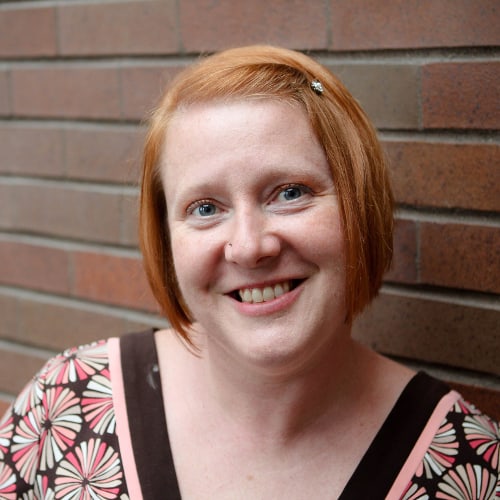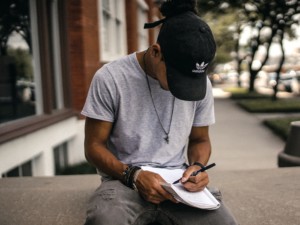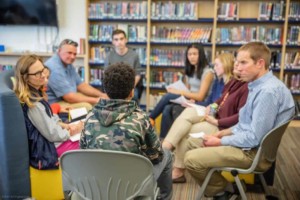Reflect versus Critique in the PBL Classroom

Humans, by nature, are reflective creatures, perhaps excessively so. After all, who hasn’t wondered over and over again, “Why did I say that? I should have. . .” or “I will never, ever, ever again wait until the last minute.”
However, as I ask my students to reflect on their latest project (building a website about their Passion Projects), I’m realizing that reflection is a very personal experience and is fraught with negativity. Even my examples above are both about what I should not do, not “I nailed that lesson. Maybe I should start with a video clip more often.”
Why do we veer towards the negative? I think it is a part of the school culture for teachers to ask students to “reflect” on their writing, when we really mean “critique” it, expecting students to analyze what they could do differently and make corrections. By misusing the word “reflect” in this instance, we are muddying waters that are already opaque. Instead, we need to clarify what we mean by reflection and model it in the classroom.
The Difference Between “Critique” and “Reflection”
Buck Institute for Education, my go-to for all things Project-Based Learning, recently published a blog by its editor in chief, John Larmer, expounding on a conversation that occurred during a Goggle Hangout with several of the National Faculty members about just this topic. Angela Marzilli commented that “critique and revision is focused on the product, and reflection is focused on the process.”
When I tease this idea out a little, I realize that teachers–myself included–may make matters more complicated by actually attempting to have students take a backward glance at both the quality of the work and their experience of it at the same time. Not only is this likely making matters complicated, it unnecessarily connects product and process. This is not to say that the two are not often related (if you don’t try very hard in the process, your product might not be successful), but it is to suggest that separate and equally deliberate conversations might be more effective.
Processing by Presenting
Specifically, I’ve asked my students to present their website in what I’m calling a “Process Presentation.” Essentially, instead of presenting their actual findings or learnings to the class, I’m instead asking them to share with us the process of doing the project–really the experience of the project, the “how it went” that can get overshadowed by how the teacher thinks it went, negating the opportunity for students to learn from their experiences.
They will be explaining how they chose a topic, created a burning question and the way their projects unfolded. They will briefly share what they did, but I’m asking them to reflect on what actually happened versus what was supposed to happen. Furthermore, they need to figure out what they could do differently next time, and celebrate what went well.
To say that some of them are highly uncomfortable with this is an understatement. For example, Kaylee, one of my top students, chose to investigate Black Holes. As one of her self-created learning experiences, she chose to read a book and then contact the author via email for an interview. Though I cautioned that he might not respond, I encouraged her to go forward with the project. She did not receive a reply, and together we reviewed her email to see if there was anything she could have done differently.
The short answer is, not really. The longer answer is that perhaps she could have found someone more local, less famous and more apt to reply to an 8th grader. We talked this over, and I know that she learned from the experience. The problem? She wanted to just scratch that project and do another one to share with the class. When I explained that she did do the project, and that things don’t always go as planned, and that we can learn from these experiences, she wasn’t satisfied. The fact is, I spend a great deal of time talking about the growth mindset, but in actuality this was the first time she was being pressed into understanding it.
Public Reflection and the Growth Mindset
What I’m learning about in my own reflection process is that I haven’t been overtly developing reflection with my students in the way that I thought I was. This isn’t the first time that I’ve asked them to reflect, but I’m seeing that asking them to reflect publicly has wildly different results than asking them to do a reflection sheet that is only shared with me, even if the reflection sheet is awesome. I think this comes full circle back to the importance of an authentic audience for Project Based Learning. Once again, the focus has to be more about what the student’s experience of the learning is than how it is reported to me. Additionally, I’m wondering now if the more successful students haven’t been reflecting honestly because they are just telling me what I want to hear instead of actually owning the process.
Too often, I think, we discuss the idea of a growth mindset and fail to recognize that there are a considerable number of students who are able to achieve the level of success a teacher has delineated for the class, but in actuality are languishing because s/he has not fully understood that growth pushes past what equals an “A.” The reflection process can change that when students who are easily “successful” in their endeavors learns that they can always improve, even if they have already met the requirements.
Reflection and Problem Solving
When I circled back to Kaylee, I asked her to reflect on how she could have attained different results. She took a few days, but eventually she told me about a conversation she had with her mom about it. “Maybe I could have sent an email to several of his accounts. I only sent it to the one on the university website. My mom said that he might have replied if I sent him a LinkedIn message or sent him a message on Twitter. I didn’t think of that. I didn’t even know what LinkedIn was, but now I know.”
I told Kaylee that sharing this experience with the class will not only help her understand how she could have done things differently, but it would also add to the collective knowledge of the class, a concept that I’ve been stressing this year as we learn together. Kaylee asked me if she could explain to the class what LinkedIn was and show us the professor’s profile as a part of her Process Presentation.
I think she will be an awesome example of a student whose reflection led to problem solving, which is, at least in part, the point. I pointed out to her that she should still share her email; I wanted her to understand that the work she had done was actually quite good and could serve as a model. As one of the “star students,” it will serve the entire class well to know that what she had tried had not worked, and to see the way she reflected on it and then problem solved.
Though the product is often directly a result of the process, I’d like to suggest that we overtly create a pause between the two. Just as I won’t teach simile and metaphor on the same day, or sometimes even the same week, because the concepts are complementary and too easily confused, I think going forward, I’m going to separate critique from reflection. Additionally, I’m going to extend the “debrief” time I build into my classes as an opportunity to more deeply reflect. Instead of including the “What would you do differently” in the editing assignment, I’ll give reflection its own space and time, since what I valued with my time is what my students know is important.
For more, see:
- Reflecting on Performance
- ‘Reading Reconsidered’ Celebrates the Connection Between Reading and Writing
- Honest Self-Help for Students, Teachers and Learning Professionals
Stay in-the-know with all things EdTech and innovations in learning by signing up to receive the weekly Smart Update. This post includes mentions of a Getting Smart partner. For a full list of partners, affiliate organizations and all other disclosures please see our Partner page.








0 Comments
Leave a Comment
Your email address will not be published. All fields are required.